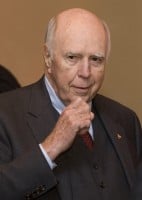
Question and Answer with Dr. Pete Dawson
Jennifer Noon e, a student at BDS University of Sheffield in the UK, asks Dr. Peter Dawson, DDS some questions. The following are her questions and his responses.
e, a student at BDS University of Sheffield in the UK, asks Dr. Peter Dawson, DDS some questions. The following are her questions and his responses.
Q: Do you believe that after the orthodontic correction of a skeletal class i crowded dentition and subsequent retention period, if the dentition was occlusally equilibrated to conform to the five principles of occlusal stability, there would be no possibility orthodontic relapse?
A: It has been my experience in following post orthodontic cases as well as restorative cases for many years that whenever relapse occurs it is always the result of failure to satisfy requirements for occlusal stability. The most common errors I see are:
- Failure to pay attention to the neutral zone so teeth end up in conflict with muscle.
- Failure to correctly harmonize the anterior guidance (very common mistake).
- Precise attention to centric relation so all teeth contact simultaneously with equal intensity when both jaw joints are seated.
If all requirements for stability are fulfilled we see almost no relapse unless there is a change in airway that alters the neutral zone. Allergies can produce that.
Q: In a mild class iii dentition with end to end anterior contact and mild generalised wear was being equilibrated, by increasing the VDO it would provide room for elongation of upper anteriors to achieve an increased overbite and length, what effect would the subsequent decrease in VDO back to the original, by regressive modelling of the dentoalveolar processes, have on the new occlusal relationship and the new condylar position in the glenoid fossa?
A: There should be no new condylar position. Class III cases should be restored or orthodontics performed at a verified CR. Changes in VDO will be compensated within the alveolar process with only minimal occlusal change if cusp-fossa relationships are correct and the anterior guidance is not in conflict with functional jaw movements.
Q: It is stated in one of your articles that it will have no effect on the occlusal relationship, therefore backward rotation of the condylar head in the glenoid fossa must be necessary to return the VDO to the original? Would this mean that there is differential remodelling of the alveolus, with greater regression of the posterior aspect of the alveolus to allow for this?
A: If the condyles are seated in CR from the start there is no backward movement as the VDO returns to original dimension. There is only rotation within the disk, which does not produce any observable clinical problem in healthy TMJs.
Q: In patients with anterior wear and a slide from centric relation to a forward jaw position that is responsible for the wear, if the condyles are seated backward and upward it will provide space anteriorly and the patients anterior teeth are restored with an increased and stable VDO.
However if this patient is a class ii skeletal base, and particularly aware of their retruded lower jaw, doesn’t this treatment accentuate the class ii skeletal relationship causing a further retrusion in the mandible relative to the maxilla, worsening the patients profile?
A: If an anterior slide from CR to maximal intercuspation is the cause of anterior wear (a common finding). You will benefit from open space at the anterior teeth when the condyles go back and UP. (See Chap 13 p 129 in Functional Occlusion).
In class II patients? yes, eliminating a forward slide by seating the joins in CR does make the maxillary overjet worse. Nevertheless, we still treat to CR and correct the jaw to jaw relationship separately. This is why we always do treatment planning on casts mounted in CR with a face bow. We select the best treatment(surgical, ortho, or restorative) to correct the problem. If a patient rejects surgery when needed, we provide a night time splint made in CR with an anterior guide ramp.
Would there be any other treatment options to create an ICP not coincident with CR to improve the patients profile, if the patient rejected orthognathic surgery?
A: No. It would be better to correct the anterior discrepancy with ortho. Sometimes a combination of ortho and restorative. Again? the reason we do diagnostic work ups on mounted casts is to guide us in making the best treatment choice.
Q: In a mild skeletal class ii, with a slightly increased overjet and overbite, that was being equilibrated, would you always want to overbuild the palatal of UR3-UL3 to occlude with the lower anteriors in ICP and produce a long centric stop in protrusion?
A: Us of anterior deprogrammer splints are a help in diagnosis. If it relieves muscle discomfort it is a pretty good sign that the cause of muscle pain is posterior occlusal interferences. Go ahead and correct the occlusion. Long term use of such splints is not indicated.










Leave a Reply
Want to join the discussion?Feel free to contribute!